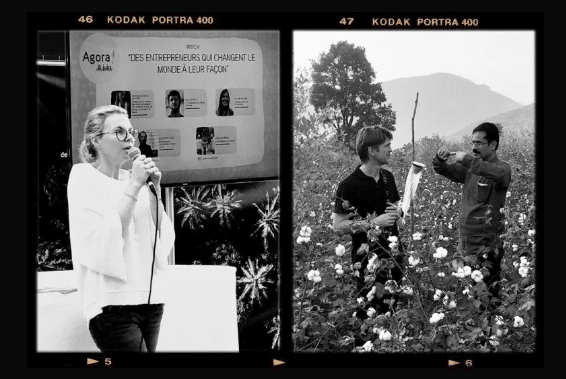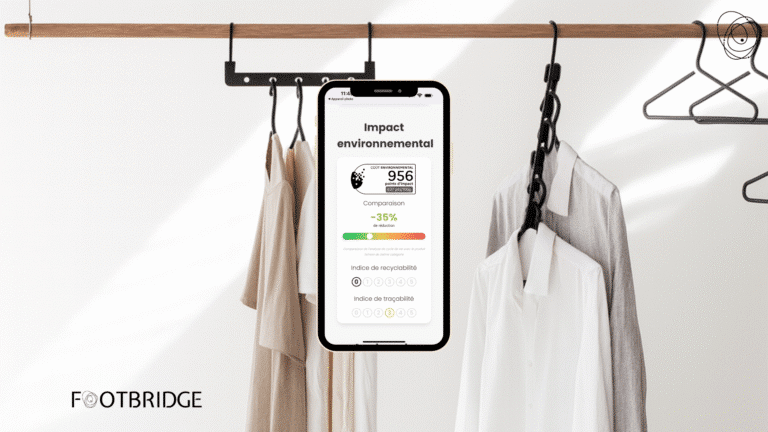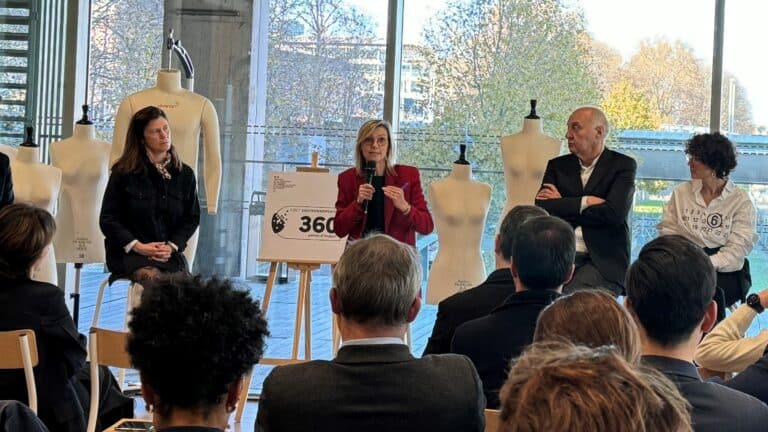Corporate Social Responsibility first appeared in 1953 with Howard Bowen, who published Social Responsibilities of the Businessman. But CSR has really become a preoccupation for most companies since the late 2010s, under pressure from regulations, particularly in Europe and France.
In 2025, the trend is towards deregulation, after having sought to impose a highly restrictive legislative framework. But the procrastination of our politicians cannot reverse a climate situation that is forcing citizens and companies to face up to and find sustainable, innovative solutions for the coming decades.
At a time when the geo-political and economic situation worldwide, and in Europe in particular, is in turmoil, to say the least, how can a fashion house combine profitability and responsibility?
This has always been a recurring question, whether in the wake of the subprime crisis or Covid-19. Companies need to demonstrate great agility in this increasingly uncertain world, at least for those with a long-term vision.
Sommaire
Desirability + Profitability + Social Commitment
Creativity, operational excellence and responsibility are not mutually exclusive. On the contrary, these 3 dimensions are essential and complementary, provided you think carefully about your business model and come up with the right answers.
In addition to strategy, it’s the operational capacity to achieve objectives, step by step, that makes the difference. CSR is a cross-functional issue that concerns not only all our teams, but also all our stakeholders, especially those involved in the supply chain.
So what kind of organization do we need?
The first step is to define the company’s CSR vision, so that it can define objectives and an action plan. Then it’s a matter of putting the plan into action and obtaining measurable results.
In many cases, however, CSR objectives are added to the company’s existing strategy and objectives. In such cases, they are rarely aligned.
To commit to a CSR approach while preserving profitability requires a rethink of the business model. This can only be done with the full involvement of senior management and the approval of shareholders.
Compliancy first?
In some companies, CSR is treated as a compliance issue. In these cases, it’s a matter for lawyers to comply with regulations. This is indeed necessary, but how can we organize the achievement of impact reduction objectives?
For the past 2-3 years, CSR has been synonymous with Excel spreadsheets and pretty annual reports. CSR managers have been swamped with carbon audits, CSRD reports and countless meetings on climate and resilience regulations or the Green Deal. Anything but concrete, pragmatic action to achieve results.
Here again, reducing carbon footprints is primarily a matter of eco-design. But financial resources and investment capacity are not scalable. It is therefore urgent to use the right technological solutions to help teams in their tasks.
CSR communication, risks and opportunities
Communicating for brands committed to doing better is also a real challenge.
To communicate well, you need to master your subject. Here again, whether it’s about eco-design, brand values or compliance with legislation, it’s not easy to speak out.
- What to say?
- How do you avoid the risk of systematic criticism or even lynching?
- How do you answer the sometimes very specific questions of certain customers?
Communication departments don’t master the issues and subjects of CSR. So they don’t have the keys to highlighting them. Conversely, a CSR Director is not a communications director…
Yet, communication is the last stage of the CSR rocket. Promoting your commitments and the results you’ve achieved is the key to building brand loyalty.
Use the right tone, provide accurate and precise information, avoid greenwashing. Once again, this requires mastery of the subject.
Finally, communicating through proof means focusing on the product, using relevant tools that are easy to deploy.
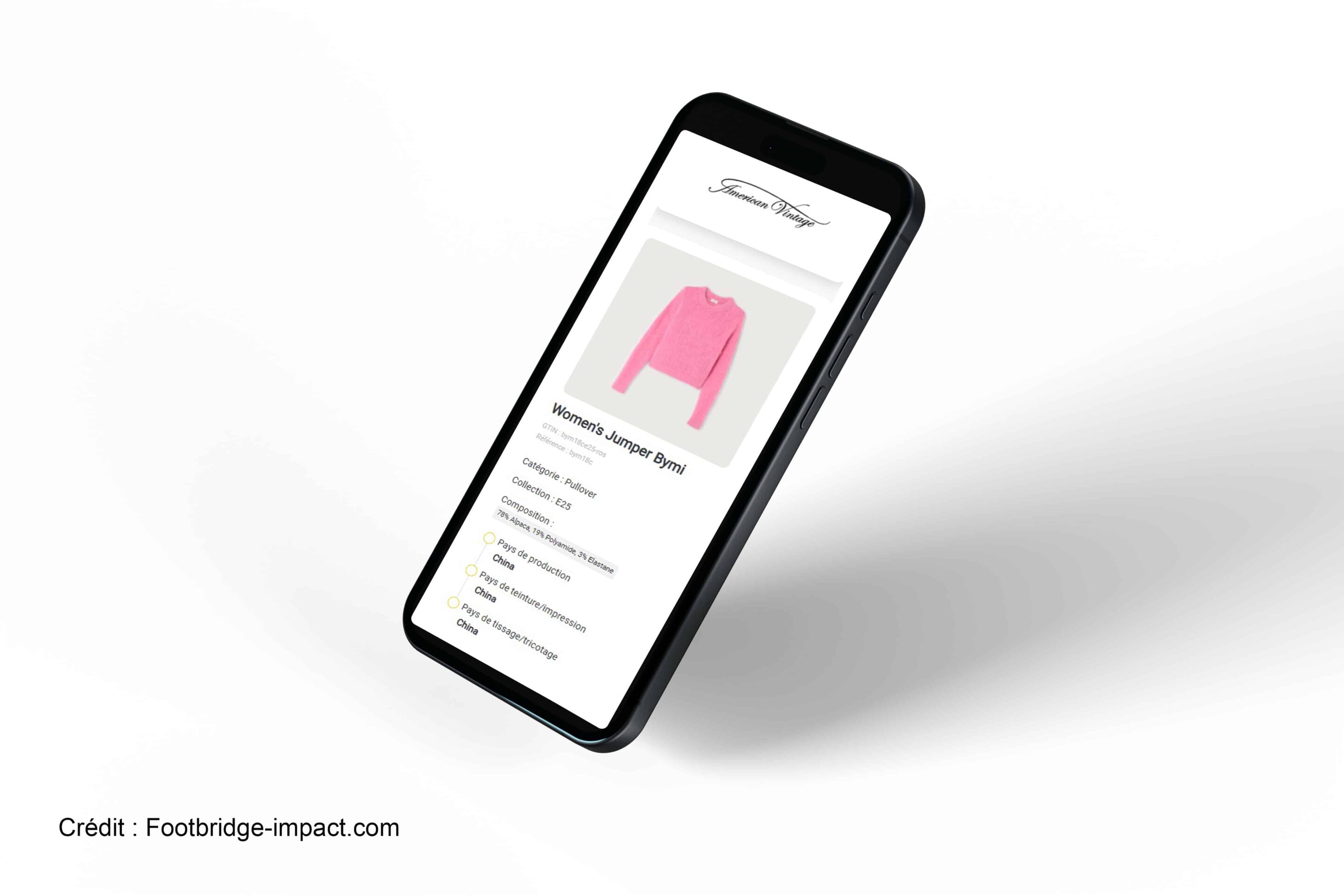
Calculate the eco-score of your clothing
Master the environmental impacts of your designs with our dedicated platform.
Schedule a demoInternalize or outsource CSR?
As always, there’s no magic bullet. There are many options, depending on the company’s size, ambitions and resources. But it is possible to take a look back, knowing that cost/investment versus footprint/benefit is a cardinal rule for measuring performance.
When companies in the apparel sector began to tackle CSR issues, they often recruited a CSR manager to structure their approach. However, CSR is a new “profession” that affects every facet of a company.
In fashion, the heart of the matter is the product. In CSR, it’s the same thing. Over 80% of a textile brand’s social and environmental impact lies in its products.
So the team in charge of CSR must focus on eco-design as a priority. Skills are gradually being acquired, but there’s still a long way to go in this area. And many CSR Directors have a legal background.
CSR is the concern of everyone in the company, not just one person or department. Ambitious objectives can only be achieved through collective involvement and the acquisition of skills at all levels. The managerial quality of such a project is therefore decisive in making giant strides or treading water.
Advantages of outsourcing CSR management in a ready-to-wear company
- Specialized expertise: An external service provider provides in-depth knowledge of CSR issues, current regulations (CSRD, DPEF, duty of care, etc.) and best practices in the textile sector.
- Objective and strategic vision: An external viewpoint enables us to identify areas for improvement and structure a CSR roadmap without internal bias.
- Time savings and optimization of resources: Outsourcing enables the company to focus on its core business without mobilizing significant internal resources.
- Better risk management: A qualified service provider can map environmental and social risks in the supply chain, draw up action plans and anticipate future regulations.
- Flexibility and adaptability: Outsourcing enables us to adapt our missions and level of support according to our needs and the evolution of our CSR strategy.
- Enhanced credibility with stakeholders: Working with a recognized expert can reassure investors, consumers and partners about a company’s CSR commitment.
Disadvantages of outsourcing CSR management
- Lack of cultural anchorage and internal integration: An external service provider may have difficulty fully integrating into the corporate culture and effectively engaging employees.
- Potentially high cost: Depending on the scope of the mission, outsourcing can represent a substantial financial investment.
- Dependence on an external player: There is a risk if the service provider leaves the mission, or if the company becomes too dependent on expertise that it has not developed in-house.
- Less responsiveness to emergencies: Unlike an in-house team, a service provider may have a longer response time in the event of a CSR crisis or unannounced audit.
- Difficulty guaranteeing skills transfer: Expertise needs to be passed on to in-house teams in the medium/long term.
- Possible conflicts of interest: Some service providers may be partners of certain suppliers, or have standardized methodologies that are not always adapted to a company’s specific needs.
- Need for rigorous follow-up: It is essential to provide a framework for the assignment, with precise objectives and follow-up of results, to avoid discrepancies between expectations and the reality of the work carried out.
This being the case, outsourcing your CSR project can be a wise decision, provided that you :
- surround yourself with an expert and trusted team, capable of covering the main CSR topics
- Define the mission and objectives
- Ensure that skills are passed on to the various in-house teams.
- Surround yourself with an external service provider capable of intervening with the Comex as well as the business teams, an auditor, a knitter or a journalist.The GOOD FABRIC x FOOTBRIDGE synergy, a decisive asset in providing a global response.
GOOD FABRIC x FOOTBRIDGE synergy, a decisive asset in providing a global solution
Our focus is on DOING. Solutions are implemented in the field.
For over 20 years, GOOD FABRIC and FOOTRIDGE’s managers have built up solid experience in creating brands and developing benchmark companies in terms of impact reduction.
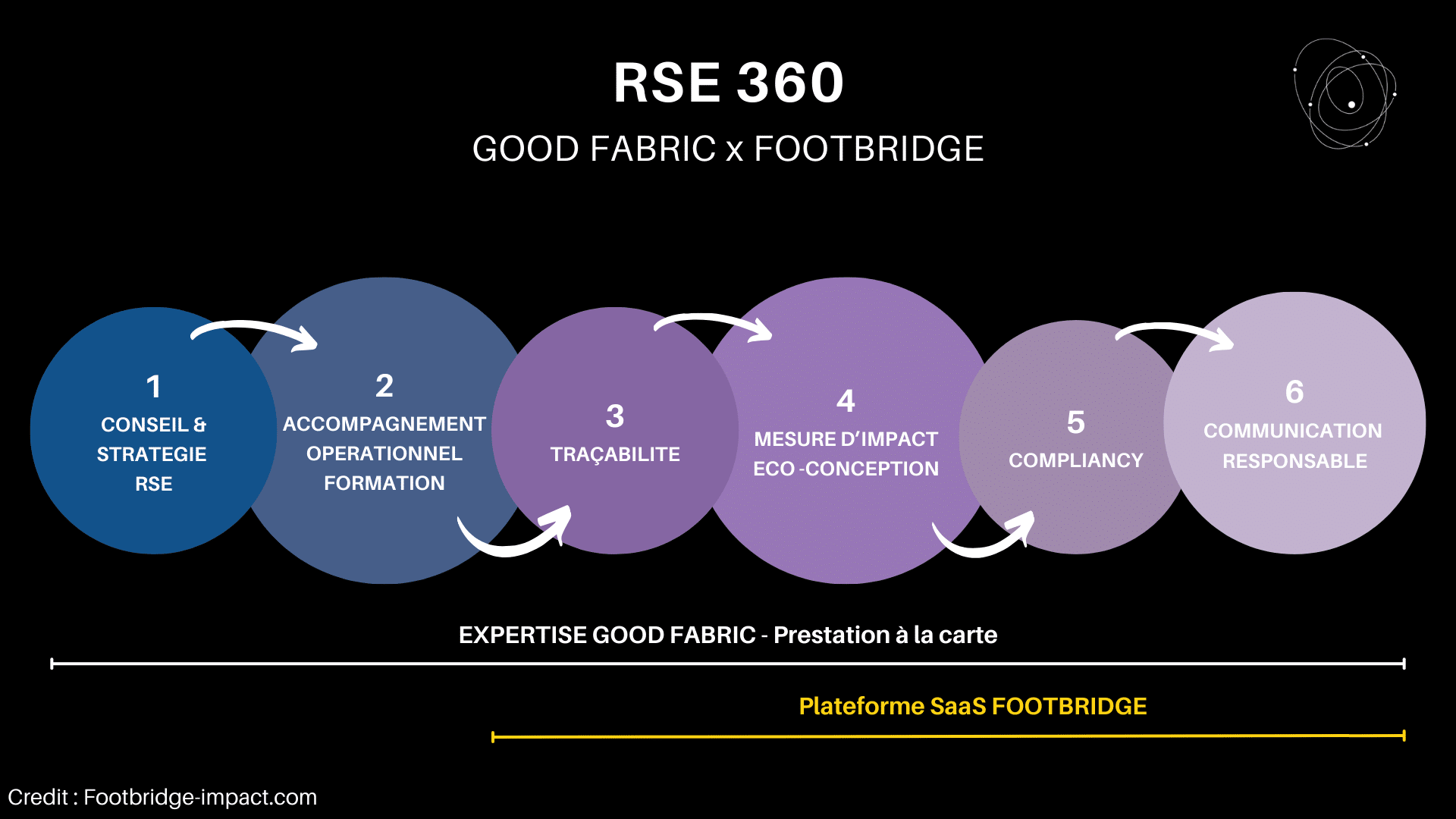
The range of services developed since 2016 within GOOD FABRIC and then FOOTBRIDGE enables us to offer an “à la carte solution” to carry out a specific mission, right up to the complete outsourcing of the CSR function.
GOOD FABRIC’s CSR management enables us to manage all CSR levers in a coordinated manner, in direct contact with our teams. They can draw on our know-how and availability to get concrete answers to their questions and strengthen their skills.
One of GOOD FABRIC’s distinctive features is also that we DO our part alongside the teams and implement the action plan previously validated with management. Because the success of any project depends on the ability to implement it.
FOOTBRIDGE the ideal platform for the fashion industry
In parallel, the deployment of the FOOTBRIDGE platform (developed by GOOD FABRIC) optimizes the productivity of traceability and impact measurement projects.
The synergy, within the same platform, between traceability and LCA calculation is key. In this way, we provide useful indicators for the eco-design and impact measurement of collections.
The ergonomic design and specific development of the platform for the fashion sector make it easy for all teams to use, without the need for special skills.
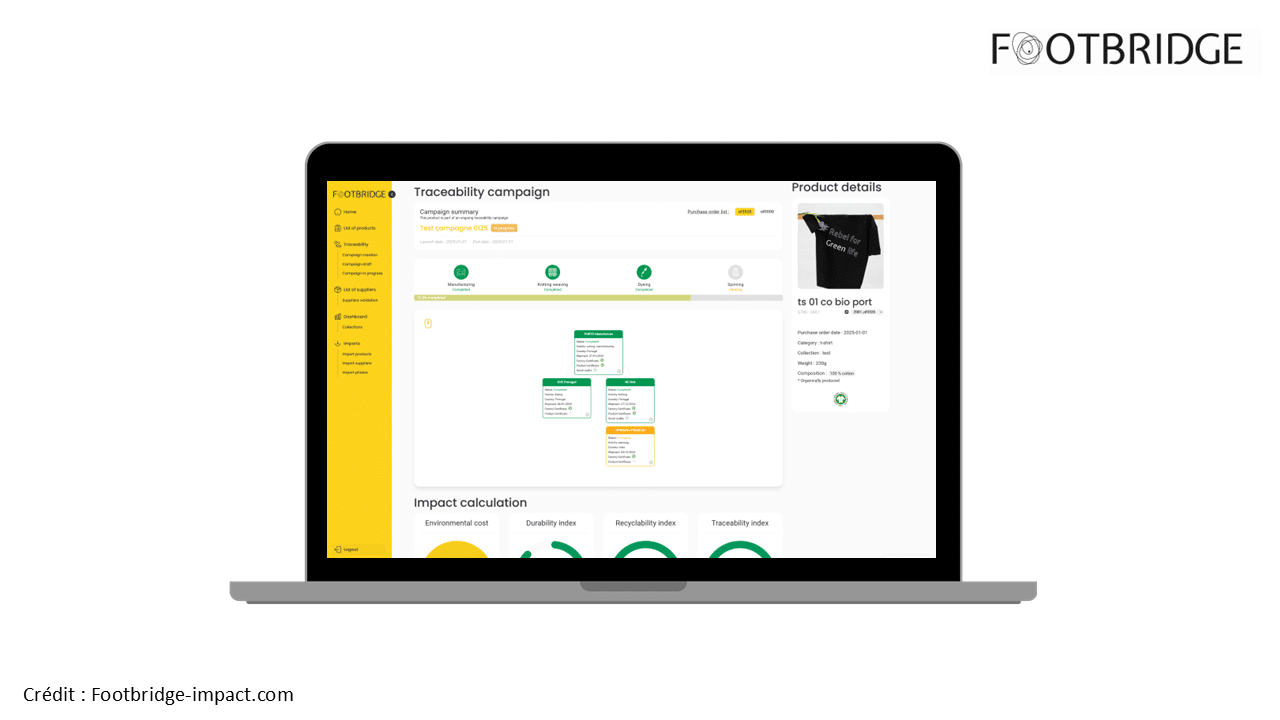
Operational efficiency and budgetary control
For example, companies that have committed themselves to traceability of their production have demonstrated their willingness to move seriously in the right direction. But many are encountering difficulties:
- lack of transparency in the supply chain
- the use of traceability platforms that are sometimes obsessed with technology, but far removed from business reality
- the difficulty of collecting relevant data, which takes up the lion’s share of resources and prevents us from concentrating on what really matters: using this data to improve practices and reduce impacts.
Among traceability and impact calculation platforms, how many have been developed by people who are familiar with the reality of a garment production chain, or the itinerant constraints involved in developing and marketing a collection? Yet this is a critical factor in proposing a solution that precisely meets users’ expectations.
Budgetary control is another key point in favor of outsourcing. GOOD FABRIC is able to offer 360° support for the deployment of FOOTBRIDGE, optimizing costs and ensuring the autonomy of in-house teams at all stages of the project.
In conclusion, is CSR outsourcing an option?
An in-house CSR team is the most widespread form of organization, and in most cases meets the objectives set. It can call on external skills for specific projects or missions.
Outsourcing CSR management can be an effective solution for structuring a sustainable and credible approach in the ready-to-wear sector, especially if the company lacks in-house expertise. However, it is advisable to have an internal referent to ensure follow-up and integration of actions into the overall strategy. A hybrid approach (service provider + in-house skills enhancement) may be an optimal solution to guarantee sustainability and consistency.
A mixed approach, with an initial outsourcing phase followed by a skills upgrade for in-house teams, may also be the right option.
As always, it’s a question of people. Finding competent, trustworthy people who understand your organization, its processes and its economic situation, so as to implement the right levers at the right time, is the first key.
Getting all teams on board internally is the other decisive factor. To achieve this, CSR skills need to be disseminated at all levels.
Last but not least, using the right tools is essential for operationalization. Because technology must help, not exhaust teams.
So anything is possible!
About GOOD FABRIC & FOOTBRIDGE
GOOD FABRIC also supports brands in their CSR strategy and implementation, the eco-design of their collections and the evolution of their business model. GOOD FABRIC was founded by Nathalie and Louis-Marie Vautier, entrepreneurs in sustainable fashion since 2004.
FOOTBRIDGE is a SaaS platform for traceability and environmental impact calculation dedicated to the fashion industry, developed by GOOD FABRIC.
The combination of GOOD FABRIC’s expertise and the FOOTBRIDGE platform offers targeted or global support, depending on objectives, enabling the operational deployment of winning strategies.
The article’s key questions
- What is CSR and when did it first appear in business?
Corporate social responsibility first appeared in 1953 with Howard Bowen’s “Social Responsibilities of the Businessman”. It has become a major concern for most companies since the late 2010s, mainly under the pressure of European and French regulations.
In 2025, despite a trend towards deregulation, the climate situation continues to oblige citizens and companies alike to find sustainable, innovative solutions for the coming decades. Against this backdrop, companies need to demonstrate strategic agility in an increasingly uncertain world, especially those that want to take a long-term view.
- Why outsource the CSR function in the fashion industry?
Outsourcing the CSR function offers a number of advantages for companies in the fashion industry. An external service provider brings specialized expertise with in-depth knowledge of CSR issues and current regulations (CSRD, DPEF, duty of care). An outside perspective helps identify areas for improvement and structure a roadmap without internal bias.
This approach saves time and optimizes resources, enabling the company to focus on its core business.
What’s more, a qualified service provider can better map the environmental and social risks of the supply chain, draw up action plans and anticipate regulatory changes, thus reinforcing credibility with stakeholders.
- How to balance profitability and CSR commitment in the textile industry?
To balance profitability and responsibility, fashion companies need to consider three complementary elements: desirability, profitability and social commitment.
Creativity, operational excellence and responsibility are not incompatible, but essential and complementary, provided you rethink your business model and find the right answers.
The prerequisite is to define a clear vision, and to define objectives and an action plan in line with the company’s overall strategy. This work requires the full involvement of senior management, and the approval of shareholders. Over 80% of a textile brand’s social and environmental impact lies in its products, so eco-design must be an absolute priority to reduce the carbon footprint while maintaining economic viability.
- What are the disadvantages of outsourcing the CSR manager's tasks?
Delegating CSR to an external service provider presents certain risks. The main one is the lack of cultural anchorage and internal integration, as a service provider may have difficulty fully integrating into the corporate culture and engaging employees.
Outsourcing can represent a significant cost, depending on the scope of the assignment. There is also a risk of dependency if the company does not develop in-house expertise, and a possible reduced responsiveness to emergencies compared to an in-house team.
Transferring skills to in-house teams may prove difficult in the medium/long term. Conflicts of interest may arise if service providers are partners of certain suppliers, or have standardized methodologies that are not adapted to the company’s specific needs. Meticulous monitoring is essential to avoid discrepancies between expectations and the reality of the work performed.
- How can CSR strategy be outsourced without going through the recruitment process?
To outsource CSR strategy effectively, companies need to surround themselves with an expert, trusted team capable of covering the main CSR topics. It is essential to precisely define the mission and objectives, and to ensure that skills are passed on to the various in-house teams.
The service provider must be capable of working with the Comex as well as business teams, an auditor, a knitter or a journalist. A hybrid approach, with an initial outsourcing phase followed by a skills-building phase for in-house teams, may be the best solution.
The use of appropriate technological tools is essential to operationalize without exhausting teams. Budget control is a key point, and solutions such as GOOD FABRIC offer 360° support including the deployment of tools such as FOOTBRIDGE, optimizing costs while ensuring the gradual autonomy of in-house teams.
- Why is responsible purchasing crucial to an outsourced CSR approach?
Responsible purchasing represents a fundamental lever in an outsourced CSR approach, particularly in the textile sector where the supply chain is complex. The lack of transparency in the supply chain is one of the main challenges for companies committed to traceability. Traceability platforms are sometimes too focused on technology and far removed from the reality of the business.
The difficulty of collecting the relevant data takes up the bulk of resources, preventing us from focusing on the intelligent use of this information to improve practices and reduce impacts.
An external service provider with in-depth knowledge of a garment’s production chain and the constraints involved in developing a collection can bring significant added value by proposing solutions that precisely meet users’ expectations, while respecting high ethical standards and promoting sustainable business practices.
- What role does communication play in CSR projects?
Communication is the last stage of the CSR rocket, and represents a real challenge for brands making a commitment. To communicate effectively, you need to master your subject, whether it’s eco-design, brand values or compliance with legislation. The fundamental questions are:
- Say what?
- How to avoid the risk of systematic criticism or even lynching?
- How to answer the sometimes very specific questions of certain customers?
Communication departments are generally unfamiliar with CSR issues and topics, and therefore lack the keys to highlighting them. Conversely, a CSR Director is not a communications director. And yet, highlighting one’s commitments and the results achieved are a lever for brand loyalty.
It’s essential to use the right tone, provide accurate and precise information, and avoid greenwashing. Communicating through proof means focusing on the product, using relevant tools that are simple to deploy.
- How does CSR impact social and environmental practices in the fashion industry?
Social and environmental impact is at the heart of CSR concerns in the fashion industry. Over 80% of this impact lies in the products themselves, which is why the CSR team must focus on eco-design as a priority. Companies that have committed to traceability of their production demonstrate their willingness to move seriously in the right direction, but often come up against difficulties.
CSR affects every facet of a company, and requires an integrated approach. Its success depends on collective involvement and the acquisition of skills at all levels. The managerial quality of such a project is crucial to making significant progress.
Tools such as FOOTBRIDGE optimize the productivity of traceability and impact measurement projects, by providing useful indicators for eco-design and impact measurement of collections. The synergy between traceability and LCA (Life Cycle Assessment) calculation is a strategic key to reducing the environmental footprint while respecting workers’ rights and supporting local communities.

